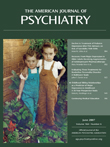BK ca Channel in Autism and Mental Retardation
To The Editor: We read with great interest the article by Frederic Laumonnier, Ph.D., et al. (1) in the Sept. 2006 issue of the Journal , as it potentially contributes to knowledge of the etiobiology of autism and may identify a novel treatment target. With the exception of two prior reports (2 , 3) , channel mutations have not been commonly observed in autism. Therefore, the study by Dr. Laumonnier et al. may represent one of the first on definitive mutations in a channel associated with autism. Yet, several complexities to the relationship between channel mutations, autism, and epilepsy are introduced by the data presented.
The most compelling finding of the article was the discovery and characterization of balanced translocation, which appeared to interrupt one allele of the KCNMA1 gene in the first intron in a patient with autistic disorder. The patients’ parents do not carry the balanced translocation, and therefore, the fact that this translocation is de novo supports the notion that it may be pathogenic. Using semiquantitative reverse transcriptase-polymerase chain reaction, Dr. Laumonnier et al. showed that BK gene expression was decreased by approximately 50% in lymphoblastoid cell lines from the patient, which is consistent with the mutation leading to haploinsufficiency.
In Figure 2 of the article, the authors showed that the BK toxin, iberiotoxin (IbTx), blocked whole-cell current from the autistic patient significantly more than it did in the comparison subject, which suggests decreased activity of this receptor, presumably because of the haploinsufficiency of the genetic mutation. However, this analysis represents a somewhat ambiguous assessment of such a change, since the authors did not provide information regarding the amplitude of the current prior to IbTx application. Rather, Dr. Laumonnier et al. presented the data as a difference score, which presumably represents the whole-cell current prior to administration of the toxin minus the whole-cell current with the toxin. If this was the case, and the autistic patient had less expression of BK than the comparison subject, then wouldn’t the pre-post difference in the current amplitude be smaller for the autistic patient? The graphs in Figure 2 seem to show the opposite effect for the autistic and comparison subjects.
Finally, Dr. Laumonnier et al. hypothesized—based on the decrease in BK channel gene expression as well as their electrophysiology experiments—that the mutation in the autistic patient may lead to a general decrease in neuronal excitability. This hypothesis is of particular interest, since a mutation causing a gain-of-function of this receptor and an increase in neuronal excitability has recently been associated with epilepsy (4) . Nearly one-quarter of patients with an autistic disorder have seizures, and therefore it has been suggested that autism may too be a disorder of neuronal excitability. However, the current haploinsufficiency mutation in autism and the hyperfunctioning mutation in epilepsy are proposed to have opposing effects on the neuronal excitability. We would be interested to know whether Dr. Laumonnier et al. have any hypotheses about how these opposite channel dysfunctions may lead to these two, often comorbid, conditions.
1. Laumonnier F, Roger S, Guérin P, Molinari F, M’Rad R, Cahard D, Belhadj A, Halayem M, Persico AM, Elia M, Romano V, Holbert S, Andres C, Chaabouni H, Colleaux L, Constant J, Le Guennec JY, Briault S: Association of a functional deficit of the BK Ca channel, a synaptic regulator of neuronal excitability, with autism and mental retardation. Am J Psychiatry 2006; 163:1622–1629 Google Scholar
2. Splawski I, Timothy KW, Sharpe LM, Decher N, Kumar P, Bloise R, Napolitano C, Schwartz PJ, Joseph RM, Condouris K, Tager-Flusberg H, Priori SG, Sanguinetti MC, Keating MT: Ca(V)1.2 calcium channel dysfunction causes a multisystem disorder including arrhythmia and autism. Cell 2004; 119:19–31Google Scholar
3. Weiss LA, Escayg A, Kearney JA, Trudeau M, MacDonald BT, Mori M, Reichert J, Buxbaum JD, Meisler MH: Sodium channels SCN1A, SCN2A and SCN3A in familial autism. Mol Psychiatry 2003; 8:186–194Google Scholar
4. Du W, Bautista JF, Yang H, Diez-Sampedro A, You SA, Wang L, Kotagal P, Luders HO, Shi J, Cui J, Richerson GB, Wang QK: Calcium-sensitive potassium channelopathy in human epilepsy and paroxysmal movement disorder. Nat Genet 2005; 37:733–738Google Scholar



